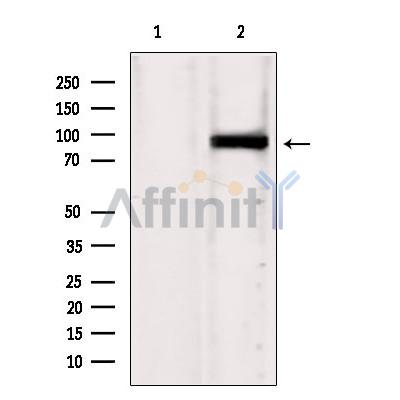IFT88 Antibody - #DF12001
| Product: | IFT88 Antibody |
| Catalog: | DF12001 |
| Description: | Rabbit polyclonal antibody to IFT88 |
| Application: | WB IHC |
| Reactivity: | Human, Mouse, Rat, Dog |
| Prediction: | Pig, Zebrafish, Bovine, Horse, Sheep, Rabbit, Dog, Xenopus |
| Mol.Wt.: | 88-95 kDa; 94kD(Calculated). |
| Uniprot: | Q13099 |
| RRID: | AB_2844806 |
Related Downloads
Protocols
Product Info
*The optimal dilutions should be determined by the end user. For optimal experimental results, antibody reuse is not recommended.
*Tips:
WB: For western blot detection of denatured protein samples. IHC: For immunohistochemical detection of paraffin sections (IHC-p) or frozen sections (IHC-f) of tissue samples. IF/ICC: For immunofluorescence detection of cell samples. ELISA(peptide): For ELISA detection of antigenic peptide.
Cite Format: Affinity Biosciences Cat# DF12001, RRID:AB_2844806.
Fold/Unfold
D13S1056E; DAF19; hTg737; Ift88; IFT88_HUMAN; Intraflagellar transport 88 homolog; Intraflagellar transport protein 88 homolog; MGC26259; Polaris homolog; Probe hTg737 (polycystic kidney disease, autosomal recessive); Recessive polycystic kidney disease protein Tg737 homolog; RP11-172H24.2; Tetratricopeptide repeat domain 10; Tetratricopeptide repeat protein 10; TG737; TPR repeat protein 10; TTC10;
Immunogens
A synthesized peptide derived from human IFT88, corresponding to a region within C-terminal amino acids.
Expressed in the heart, brain, liver, lung, kidney, skeletal muscle and pancreas.
- Q13099 IFT88_HUMAN:
- Protein BLAST With
- NCBI/
- ExPASy/
- Uniprot
MKFTNTKVQMMQNVHLAPETDEDDLYSGYNDYNPIYDIEELENDAAFQQAVRTSHGRRPPITAKISSTAVTRPIATGYGSKTSLASSIGRPMTGAIQDGVTRPMTAVRAAGFTKAALRGSAFDPLSQSRGPASPLEAKKKDSPEEKIKQLEKEVNELVEESCIANSCGDLKLALEKAKDAGRKERVLVRQREQVTTPENINLDLTYSVLFNLASQYSVNEMYAEALNTYQVIVKNKMFSNAGILKMNMGNIYLKQRNYSKAIKFYRMALDQVPSVNKQMRIKIMQNIGVTFIQAGQYSDAINSYEHIMSMAPNLKAGYNLTICYFAIGDREKMKKAFQKLITVPLEIDEDKYISPSDDPHTNLVTEAIKNDHLRQMERERKAMAEKYIMTSAKLIAPVIETSFAAGYDWCVEVVKASQYVELANDLEINKAVTYLRQKDYNQAVEILKVLEKKDSRVKSAAATNLSALYYMGKDFAQASSYADIAVNSDRYNPAALTNKGNTVFANGDYEKAAEFYKEALRNDSSCTEALYNIGLTYEKLNRLDEALDCFLKLHAILRNSAEVLYQIANIYELMENPSQAIEWLMQVVSVIPTDPQVLSKLGELYDREGDKSQAFQYYYESYRYFPCNIEVIEWLGAYYIDTQFWEKAIQYFERASLIQPTQVKWQLMVASCFRRSGNYQKALDTYKDTHRKFPENVECLRFLVRLCTDLGLKDAQEYARKLKRLEKMKEIREQRIKSGRDGSGGSRGKREGSASGDSGQNYSASSKGERLSARLRALPGTNEPYESSSNKEIDASYVDPLGPQIERPKTAAKKRIDEDDFADEELGDDLLPE
Predictions
Score>80(red) has high confidence and is suggested to be used for WB detection. *The prediction model is mainly based on the alignment of immunogen sequences, the results are for reference only, not as the basis of quality assurance.
High(score>80) Medium(80>score>50) Low(score<50) No confidence
Research Backgrounds
Involved in primary cilium biogenesis. Also involved in autophagy since it is required for trafficking of ATG16L and the expansion of the autophagic compartment.
Cytoplasm>Cytoskeleton>Microtubule organizing center>Centrosome>Centriole. Cell projection>Cilium. Cytoplasm>Cytoskeleton>Cilium basal body. Cytoplasm>Cytoskeleton>Microtubule organizing center>Centrosome. Cytoplasm. Cell projection>Cilium>Flagellum.
Note: Colocalizes with ENTR1 and gamma-tubulin at the basal body of primary cilia. Colocalizes with ENTR1 and pericentrin at the centrosome.
Expressed in the heart, brain, liver, lung, kidney, skeletal muscle and pancreas.
Restrictive clause
Affinity Biosciences tests all products strictly. Citations are provided as a resource for additional applications that have not been validated by Affinity Biosciences. Please choose the appropriate format for each application and consult Materials and Methods sections for additional details about the use of any product in these publications.
For Research Use Only.
Not for use in diagnostic or therapeutic procedures. Not for resale. Not for distribution without written consent. Affinity Biosciences will not be held responsible for patent infringement or other violations that may occur with the use of our products. Affinity Biosciences, Affinity Biosciences Logo and all other trademarks are the property of Affinity Biosciences LTD.




